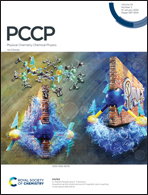The anti-corrosive behavior of benzo-fused N-heterocycles: an in silico study toward developing organic corrosion inhibitors†
Abstract
The work provides a computational protocol to predict the anti-corrosive performance of organic molecules through three successive phases of calculations; electron propagator theory (EPT), Monte Carlo (MC) simulations, and the density functional based tight-binding (DFTB) method. The protocol was applied to investigate the influence of two structural factors on the anti-corrosive performance of benzo fused-N-heterocycles (BFNHs) against the Fe(110) surface in an acidic medium; positional isomerism and the gradual insertion of nitrogen atoms in the heterocycle ring. The choice of BFNHs is attributed to their anti-corrosion activity and their use as building blocks in the molecular structure of many organic inhibitors. The findings indicate that EPT is a safe method for calculating the quantum chemical descriptors of the isolated molecules. Besides, the current work recommends using MC simulations and the DFTB method to describe the physical and chemical adsorption, respectively. Unexpected results were observed, as the gradual insertion of nitrogen atoms is not a specific factor for improving the inhibition efficiency of BFNHs. The findings were crystallized in equations linking the physical and chemical adsorption energies with the quantum chemical descriptors with a correlation exceeding 0.75. Besides, the peri steric hindrance plays an influential role in chemical adsorption. Intriguingly, the continuous introduction of nitrogen atoms does not increase the efficiency of the inhibitor along the way. For example, phthalazine exhibited better efficiency than benzotetrazine. In light of the above, the present protocol helps understand the anti-corrosive behavior of organic inhibitors and provides a feasible method to develop novel corrosion inhibitors.



 Please wait while we load your content...
Please wait while we load your content...